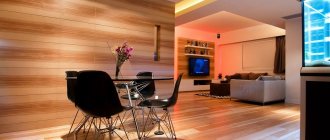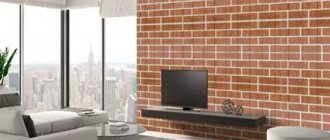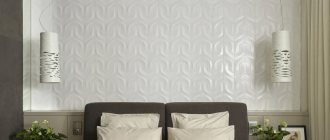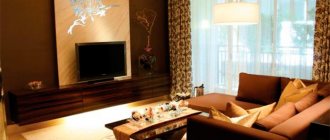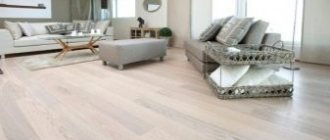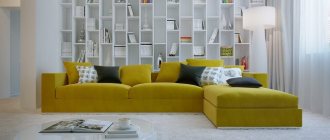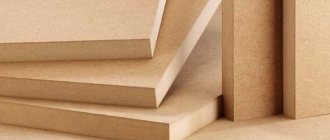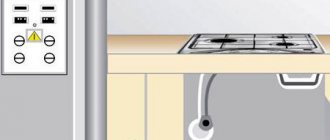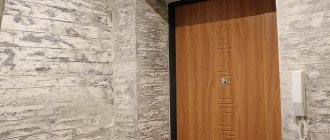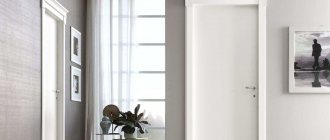Finishing with plastic panels is increasingly used for bathrooms, showers and even technical rooms. Modern design and improved quality have made them worthy competitors to tiled flooring. When choosing plastic panels for repair, familiarize yourself with their technical characteristics in order to avoid unpleasant moments in use. A high-quality panel will serve for many years without losing its attractive appearance, but it requires some maintenance.
Advantages of finishing with plastic panels
- Panels are an ideal material for doing DIY repairs
. Installation of such a covering is simpler than wallpapering. To work you will need a screwdriver, a cutter and a simple level. With some care, even an inexperienced repairman can handle finishing with plastic panels. - Ultra-fast installation
. Due to the fact that the panels are adjusted to the height of the ceiling and are instantly joined to each other, the actual installation time can take only 1 day. The process is accelerated by the use of special clips and lathing. Corners and joints are also formed in a matter of minutes using special fittings (corners, end strips, borders). At the same time, the house will be clean, since the panels do not generate dust, there is no need for a special solution that can drip onto the floor, and so on. - High quality material
. Modern plastic wall panels are often impossible to distinguish from tiles. They are made of durable textured plastic and have a frequent cell structure. A room decorated with such panels takes on a pleasant, neat appearance. - PVC surface painting
is not subject to fading under the influence of temperature or humidity, it does not emit any harmful substances even when exposed to the sun. The material is also resistant to cool air. Thanks to this, plastic panels can also be used for finishing balconies, loggias and terraces. - Extensive selection
. Plastic wall panels are available in a wide variety of designs. The most popular are PVC panels with wood and marble textures of all possible shades. It is easy to find plastic panels in bright colors, matte and glossy, with glitter or a rough surface. If desired, you can create a unique design by ordering vinyl stickers. - Affordable price
. With all its advantages, PVC panels remain a fairly inexpensive finishing material. High-quality tiles, including installation, will cost several times more. - Easy care
. Keeping the panels clean is very easy. Since they do not have deep joints or protrusions, colonies of bacteria do not develop on them and mold does not grow. The optimal care for plastic panels is to wipe them with a dry cloth to remove moisture and wash them from time to time with any mild cleanser, such as dishwashing gel or bath cleaner. - Environmental Safety
. PVC panels of modern quality are allowed to be installed even in hospitals and children's institutions. A similar material is used in the manufacture of surgical accessories and utensils. - Fire resistance
. The melting and burning temperature of a plastic panel is about 400 degrees Celsius. This is a very good indicator among finishing materials. In this regard, PVC panels are safer than wooden lining, vinyl coverings, cork and many other wall coverings, which ignite at lower temperatures and immediately release hazardous combustion products.
The active use of plastic panels is fully justified by their strengths. Today, the main reason for replacing such wall coverings is the desire to freshen up the decor. New panels can be easily mounted on existing sheathing.
Despite all the advantages of finishing with plastic panels, there are several points that should be considered when choosing this material. This will save you from unsuccessful purchases and disappointments during use.
Disadvantages of finishing with plastic panels
- Possible fakes!
All of the above advantages do not apply to unexpectedly cheap and thin Chinese-made panels with a cell width of 10-12 mm. They were the first to appear on the Russian market and are still on sale. Such panels should not be used even for finishing ceilings or little-used rooms! They do not fit well with each other, can bend and break during installation, and the quality of the PVC in them is unknown even to the manufacturer himself. - Average impact resistance
. A high-quality panel with a thick outer layer and frequent cells, mounted on a high-quality frequent lathing, can withstand light everyday load. For example, you can lean your hand on it without any consequences, but the coating may not withstand a strong blow with a fist or a heavy object. This property is compensated by the rarity of such situations and the ease of repair. The covering can be disassembled and broken planks can be replaced. - Small selection of colors for corner and end strips
. Most often they are produced in white, brown and beige. This problem can be solved by more complex but effective installation without planks, which can be performed by a competent installer - Installation quality requirements
. For the sheathing, it is necessary to use only special plastic strips and fasten them level, strictly horizontally, at a distance of 35-45 cm from each other. The wooden base under the panels can become deformed and ruin the wall covering!
According to the type of joint, plastic panels are divided into:
Seamless
the most common type of panels recently. However, a seamless joint is called quite arbitrarily. No matter how you join the panels, the joint will still be visible, especially if the panels are white and glossy, as in the photo:
Those. the surface, of course, will be quite flat and smooth, but it will not be possible to achieve the ideal, as when using seamless stretch ceilings or drywall.
In addition, plastic panels are sometimes deformed due to poor storage or transportation conditions, or they are simply of poor quality; it is almost impossible to join such panels without a seam. If several planes will be sewn up in one room (for example, the ceiling and walls) or one plane (for example, the ceiling) in different rooms, then you can sort through the panels, selecting those curved in one direction. The fact is that the panels, as a rule, are packaged so that the front surface is in contact with the front, and the back surface with the back, thus reducing the risk of scratches (reduced, but not eliminated) and if the panels are curved, then one plane is taken for covering every second, i.e. half of the panels are from the pack, the rest are used to cover another surface. Moreover, the frame for seamless panels must be made with maximum precision. In a word, if increased aesthetic requirements are imposed on surfaces finished with seamless panels, then such panels must be selected with special care. If possible, it is better to check the quality of the panels immediately in the store by trying to join two panels from a pack.
Seamless plastic panels have approximately the following cut:
This allows panels to be joined virtually seamlessly:
The width of seamless panels is usually 20, 25, 30 and 33 cm.
Embossed
Such panels are often called “lining”, as they imitate wooden “lining” panels.
As a rule, this is the cheapest or most expensive type of plastic panels. The use of such panels is most preferable when installing ceilings on wooden structures and, in general, if slight deformations of the load-bearing structures are possible. For example, in the private sector there are often cases when a house “breathes” due to an incorrectly made foundation, i.e. In summer, cracks on the walls increase, and in winter they decrease, or vice versa. In such cases, the panels may also diverge or converge slightly, but the raised joint will make such a divergence within a few millimeters almost unnoticeable.
Plastic panels - lining have approximately the following section:
Therefore, when joining the panels, a relief seam is obtained:
Sometimes the panels have a cut like this:
This allows you to speed up the installation of panels, which is important for large volumes of work. Plastic panels - linings come in widths of 10, 12.5, 15, 20, 25, 30, 33 cm.
With rustication
This is a cross between seamless and embossed panels. Panels with such a joint are not found very often, but they do occur. The surface finished with such panels will look something like this:
In cross-section, the joint of the panels looks like this:
The width of the rusticated panels that I had to work with is 38.5 cm.
In addition to these important characteristics, the following influence the choice:
Pros and cons of suspended ceilings in cold rooms
From the above, the conclusion suggests itself that at sub-zero temperatures it is better to use synthetic fabric. But not everything is so simple.
- Firstly, there is an alternative in the form of expensive special films that work great in houses without heating. They do not deteriorate from frost and temperature changes, maintaining their properties for many years. True, not everyone can afford such pleasure. In addition, the choice of colors and textures is much more modest compared to conventional film, and the maximum width of such material does not yet exceed 3 m.
- Secondly, with all the advantages, fabric ceilings are susceptible to the formation of fungus. And if the roof leaks, they will not save you from flooding. Another drawback: with high dampness in a cold room, synthetic fabrics become saturated with moisture. All this leads to irreparable damage to the material, which will have to be replaced. In addition, if it is necessary to dismantle the ceiling, for example, to gain access to communications, installing the canvas back is very problematic. The fact is that after stretching, the excess fabric is cut off and when re-installed there will be practically nothing to grab onto. Although there are exceptions here.
- Thirdly, some unheated rooms are not cooled to sub-zero temperatures even in unusually harsh winters. Balconies and loggias that are well insulated from the outside can be passively heated by adjacent warm rooms. Therefore, PVC film is often used as a ceiling covering.
Thus, in order to make the right choice, you need to carefully study the operating conditions of a particular room, weigh the pros and cons, only then can you determine the most suitable material.
Parameters of plastic panels:
Designer:
- Color . Everything here is purely individual and without any recommendations. But as a rule, if difficulties arise with choosing a color, then white panels are purchased. White and black are universal colors and go well with any other.
- Drawing. If the plastic panels have a pattern, then this pattern imitates some material or pattern. Almost always it is marble, granite, sections of rocks, but imitation of mats, fabric, as well as wood, leather, or an ornamental pattern are also possible. The more contrasting and multi-colored the pattern, the stronger the effect on the nervous system. In addition, sometimes it may be difficult to select a pattern; in this case, panels need to be purchased with a good margin for cutting.
- Gloss level. Plastic panels can be matte, glossy, semi-gloss. There is no difference between them other than design preference. To obtain gloss, a lamination layer is applied to the front surface of the panels.
Operational and design:
- Surface texture. As a rule, plastic panels have a smooth surface. But on expensive panels with a pattern that imitates natural materials, the surface may be slightly embossed. On the one hand, this brings the appearance of the panel as close as possible to natural material, on the other hand, it is more difficult to care for such panels and therefore, in my opinion, it is not rational to cover the walls in the bathroom and kitchen with such panels, but again, there are no comrades according to taste and color.
- Durability. Of course, strength and plastic panels are poorly compatible concepts. It's easy to damage plastic panels. I think everyone has seen the disastrous results of using plastic panels for wall decoration in public places. However, the thicker the walls and partitions (stiffeners) of the panel, the stronger it is, although recently the thickness of the walls and stiffeners has only been decreasing.
- Chemical resistance. Any plastic panels can easily withstand treatment with modern detergents, but it is better not to take risks and use detergents with a minimum content of chemically active components.
Quality:
In addition to the fact that the panels may be “misbehaved,” the front surface of the panels may have scratches, dents, cuts, permanent stains, poor-quality lamination layer and other defects that are quite easy to see after unpacking the panels. It’s better to do this right in the store, so as not to take the panels back later and not quarrel with the sellers.
Due to the nature of the bathroom, few finishing materials can be used when renovating this room. But if earlier it was only ceramic tiles, now the latest developments in this area allow you to have a larger selection of materials that will help you realize any of your fantasies. And as an example, we will look at the use of plastic panels for the bathroom. They are also called PVC panels.
Today, they confidently occupy second place after tiles, since they have undoubted advantages, which we will discuss below, and also allow you to quickly and efficiently decorate a bathroom at minimal cost. Even if you are not a professional in this matter, you can completely cope with all the work yourself.
In addition, in any hardware store you will find a large assortment of plastic sheet panels that imitate not only all kinds of textures, but also a wide color palette and patterns. This allows the use of plastic panels in any room, regardless of its size, although designers recommend using light shades in small bathrooms to make it visually larger.
Plastic panels for bathroom
When purchasing plastic sheet panels, try to carefully inspect them so that they have as few protrusions and cracks as possible, since in the future moisture will accumulate in these places, which will lead to the growth of mold and mildew, not to mention dark spots that are unlikely to decorate your bathroom. And if you still want to combine tiles and ceramics, then plastic sheet panels for tiles are suitable for you.
Installation
You have two options for attaching plastic sheet panels:
- using self-tapping screws;
- or glue.
In the first case, you will have to attach guides to the walls, which are also sold in hardware stores. The advantage of this option is that you will not need to perfectly align the walls in the bathroom, although leaving bumps or depressions is also not recommended. The downside is that you will have to spend a lot of time and effort to secure the sheet panels, and also drill a lot of holes for self-tapping screws.
Sheet panels for bathroom
In the second case, you will simply need to carefully plaster the walls, since you will be gluing plastic panels to a bare surface, without using any other fasteners, which means everything must be perfect, otherwise it will affect the quality of the finish. Here you will save a lot of time, but the disadvantage of this option is that if you want to remove the panels and replace them with new ones, you will have to tinker a lot, tearing them off the walls in the literal sense of the word. So it's up to you to decide which one to choose.
If you settled on guides, then you will attach them horizontally to the floor under the ceiling, below and in the middle. But if you want to make a more durable structure, you can additionally secure a pair of guides at about a quarter of the distance from the floor to the middle of the wall, repeating the same at the top.
Here's what you have to do when installing plastic sheet panels in the bathroom:
But if the walls in the bathroom are covered with plasterboard, then the best option is hidden fastening brackets, since this material gives perfectly smooth walls and you do not have to install guides and thereby save centimeters in small rooms, not to mention time. But if you have concrete or brick walls, then for each individual bracket you will have to drill holes and put pins in them. But when installing plastic panels on guides, you will screw screws into the panels or use fastening brackets.
By the way, if you bought an apartment in a new building, then it is better to use plastic sheet panels in the bathroom, because in the first 3-4 years, the house will shrink, which slightly deforms the walls and can completely warp the tiles.
Paneled walls
We use self-tapping screws
In order to install plastic panels on the sheathing using staples or screws, you will need the following tools and materials:
- PVC panels in the required quantity, plus with a small margin;
- profile for sheathing construction;
- plastic profiles or wooden blocks;
- hammer;
- construction stapler with a set of staples or self-tapping screws (nails);
- a construction knife and a hacksaw for metal with a fine tooth;
- screwdriver;
- roulette;
- pliers;
- pencil or marker;
- building level;
- ladder.
Before attaching plastic decorative panels, treat the finished surface with special moisture-resistant compounds that prevent the growth of fungi. It is better to use plastic profiles, because the wood will collapse under the influence of moisture in the bathroom. Mount the profiles on the wall horizontally to the floor with a distance of up to 5 cm, while you will install the panels themselves perpendicularly, otherwise moisture will accumulate in the joints, which will lead to the growth of fungus between the plastic bath panels.
When installing profiles, constantly monitor their installation using a building level. Otherwise, the PVC panels will not stand up straight and the coating will have differences. In most cases, fastening begins from the left corner to the right or from the far corner to the doorway. But you can be guided by your ideas regarding ease of installation.
There is a huge selection of panels on the market
In the corner where you start work, install the finishing element, since you will not be able to do this later. Each of the PVC panels consists of two fastening shelves: on the left there is a narrow part (shelf), which you will insert into the groove of the already installed panel, and on the right there is a wide shelf, thanks to which the panel is fastened to the sheathing with screws or staples.
The first PVC panel is inserted with a narrow shelf into the groove of a pre-installed corner, and attached to the sheathing with staples (screws). All other plastic sheet panels are installed according to the same scheme - one is inserted into the other and secured. The main thing is that all parts fit tightly together.
Where the plastic panels come into contact with corners, window openings or door frames, you will attach special mounting components (finishing elements). This will allow you to beautifully and neatly decorate areas near windows and doors, as well as corners. But in order for air to flow under the fixed plastic panels, you should leave a small gap near the floor and under the ceiling. Additionally, these gaps will make it possible to compensate for changes in the linear dimensions of PVC panels under the influence of temperatures in the bathroom.
Technology does not stand still, and you can attach sheet panels using a special plastic profile and clips. What are the advantages of this method:
Liquid Nails
If you have good, even walls in your bathroom, then you can do without lathing and immediately glue plastic sheet panels to the wall. You can use a product such as liquid nails or other special glue designed for this type of work in the bathroom. But keep in mind that you will not be able to use those formulations that contain organic solvents.
For work in this case, you will need the following tools:
- glue brush;
- putty knife.
- a soft sponge or rag to remove excess glue.
Here's what you have to do to make sure everything works out correctly and you don't have to redo anything:
At the same time, do not forget about installing finishing elements to make the bathroom interior beautiful.
How do stretch ceilings behave in winter without heating?
If you plan to install a suspended ceiling in an unheated room, you need to approach the choice of material most responsibly. Here everything depends on climatic conditions, or, more precisely, on the temperature in the room in winter. A summer country house or cottage in cold weather, as a rule, is not heated. In any case, most owners prefer to spend the winter in warm apartments.
The best canvas for the ceiling in a cold house will be synthetic fabric, since polyester does not harden at sub-zero temperatures, while PVC film becomes brittle and brittle.
A vinyl stretch ceiling will crack in the cold, as the membrane tension increases to the limit. The process of destruction is accelerated by sudden temperature changes that are characteristic of our region.
Fabric fabric has another advantage - it is not afraid of hot weather. And the tension of the elastic film weakens when heated, and sagging may even appear. Of course, when the ceiling cools down, it restores its original appearance, but at the same time additional operational loads arise that affect the service life of the coating. Of course, there is no point in constantly turning on the air conditioner in an empty country house, just as there is no point in heating it in winter. In addition, in cold weather, a country building can become a refuge for mice, and PVC film can become the object of their close attention.
What is this material?
The facing material is plastic panels. They have internal perforations and a pattern printed on the front part. The length of the panels is usually 2 m 70 cm or 3 m. Material of this size is most often enough to decorate any premises. The cost of the material is low, which attracts buyers. Tiling can cost several times more. The panels are easy to install.
The stores offer a wide range of materials. You can choose any color. You need to choose plastic panels in light colors for a small area. Several different colors go well together.
The panels in the bathroom can be installed independently, without the involvement of outside force. Their standard height allows you to close the gap from floor to ceiling. The width is usually 25 cm. But when choosing, you need to look at the dimensions, since they may be different for some manufacturers. For 1 m of wall or ceiling, 4 panels are needed. It's quite easy to calculate the total amount of material per room. For fastening, you also need to purchase guides and corners, which are called profiles or moldings.
How to choose quality material?
Quality is a prerequisite for this material. Slabs that do not meet the standards will break during processing, have different thicknesses and shades even in the same batch, and will require immediate replacement.
When choosing a canvas, you should pay special attention to the manufacturer . According to user reviews, Russian-made slabs, at a lower price, are not inferior in quality to European ones. However, the most important criterion is strength .
High-quality polyvinyl chloride boards must have thick lamellas, and their surface cannot be dented with a finger. When bending, they should not make any extraneous sounds or break immediately. When purchasing plain sheets, it is better to open the packages and make sure that they are all the same tone.
PVC stretch ceilings do not require special care; you just need to wipe the surface with a damp cloth a couple of times a year.
Pipes made of cross-linked polyethylene have a high density and increased impact strength, due to which they are widely used in the creation of heating systems. Read more
What one-component and two-component adhesive compositions are used for gluing plastic? Read more
Advantages of PVC panels and bathroom finishing
Finishing panels have a number of advantages compared to other materials:
- excellent moisture resistance;
- low cost;
- rich color range;
- the ability to join parts vertically and horizontally;
- durability;
- wear resistance;
- ease of assembly.
Moisture resistance allows the material not to get wet or deform. Special locks form a solid canvas, through which water also does not penetrate. Plastic costs much less than tiles. Various colors allow you to create any design in the room. Holes should be cut for lamps and pipes. No special experience is required to work with panels.
The work of installing plastic is carried out in several stages:
- it all starts with preparing the wall;
- the fastening method is selected;
- panels are cut to length;
- a plastic corner is placed in the corner;
- the panel is inserted and secured to the sheathing;
- the remaining parts are installed.
First you need to clear the room of unnecessary things. Then the old finish is removed from the walls. If the wall is smooth and does not require repair, then it is enough to get a good glue to which the panels will be glued. But this method is not the most common. It is better to make a small sheathing with your own hands from special guides or wooden slats treated against moisture. The sheathing elements are attached to the wall using dowels. The distance between the slats is 40-50 cm. The flatness is checked by level and rule.
When installing panels yourself, you most often have to cut them to width. This can be done with a sharp knife. After completing the main work, the joints and corners can be sealed with sealant to prevent moisture from entering. It is recommended to install plastic panels in a house older than 3-5 years. A new house can settle and damage the cladding. If the bathroom has a heated towel rail, then a distance of 3-4 cm must be left between it and the lined surface, otherwise the plastic may be deformed due to temperature.
Lined surfaces are very easy and simple to clean, they drill well, and moisture does not pass through them. Tools and materials are required to complete the work.
Among modern finishing materials, plastic panels are very popular. And all this because they are light, hygienic, can be easily attached to walls made of any material, are not afraid of moisture and are not subject to rotting. Plastic panels made of polyvinyl chloride (PVC) are made by extrusion, which gives them the necessary strength and rigidity. In this article we will define the main criteria for choosing this finishing material.
Today, the industry produces a huge selection of plastic panels produced in Turkey, China, Russia and Ukraine, differing in appearance, color, degree of gloss and other characteristics. In any hardware store, your eyes widen from their abundance and variety, and confusion sets in: so which panels to choose?
All panels are conventionally divided into ceiling and wall. There is no direct ban on the use of wall panels on the ceiling, and ceiling panels on walls, but a light test with finger pressure clearly interprets that, having low strength, these panels cannot be used for wall cladding.
An additional distinguishing element is the length. Typically, ceiling panels are 6 or 12 m long, and wall panels are shorter - 2.7, 3 and 6 m.
The thickness of ceiling panels is gradually being reduced by manufacturers; previously it was 8mm, then it became 7mm, now 5 and even 4mm are found, and wall panels are usually produced with a thickness of at least 10mm.
Many buyers consider the cheapest panels, but do not want to pay attention to the fact that a quality product cannot be cheap.
After all, the vast majority of Chinese plastic panels are made from low-grade raw materials, poor adhesives and varnishes. In the future, they will quickly lose their appearance and, most importantly, will begin to release toxic substances; even the possibility of provoking an allergic reaction of the human body cannot be ruled out.
So, you should purchase panels thoughtfully, thoroughly considering and paying attention to the following factors. The main types of plastic panels are:
- 1. Plastic lining - used in the decoration of walls and ceilings; special fastening brackets are used for fastening. Relief panels are often called lining because they create an imitation of a wooden “lining” panel. 2. Plastic panels for tiles. It is advisable to use square tiles with a width from 30 to 98 cm. 3. Sheet panels - resemble plywood. Their main difference lies in installation - fastening is done with glue or nails. The joints are sealed with sealant or sewn up with slats that have the structure and color of the panels
From the point of view of room design, emphasis should be placed on the fact that there is a varied color palette of panels available for sale, allowing you to satisfy any desire of the buyer.
All panels are conventionally divided into glossy, matte and semi-gloss.
Their technical characteristics are the same, and the difference lies solely in the surface layer. This is achieved by using varnish, which creates a layer of protective film on the front surface.
When choosing plastic panels, you need to carefully study the following parameters:
- 1. Thickness of the front part - greater thickness has significant strength.
2. The number of stiffeners - the more, the stronger the panel. The external condition of the stiffeners must be identical without visible deformations. A high-quality panel has more weight, which corresponds to its thickness and the number of stiffeners.
3. The outer surface must be uniformly painted, and viewing the stiffeners is not permissible. It’s easy to check the quality of the panels - just press it down with a deflection of up to 50% and look at the result. High-quality panels do not leave dents, mainly due to the low chalk content.
4. The panels must fit tightly and rigidly into the groove. The type of joint in panels can be seamless and embossed. The most common currently is seamless, but it should be called conditionally seamless, because even with the highest quality installation, the joint is still visible.
Poor manufacturing or improper storage and transportation of plastic leads to its inevitable deformation and, as a consequence, to the impossibility of ideal joining of its parts.
Basic physical and chemical properties of PVC
| Molecular mass | 40000-145000 |
| Self-ignition temperature, C | 1100 |
| Ignition temperature, C | 500 |
| Flash point, C | 624 |
| Density, g/cm3 | 1,34-1,34 |
| Bulk density, g/cm3 | 0,4-0,7 |
| Decomposition temperature, C | 100-140 |
| Glass transition temperature, C | 70-80 |
Characteristic advantages and disadvantages of plastic panels
Like any material, plastic panels have their advantages and disadvantages. Let's start with the positives.
According to manufacturers, all plastic panels are environmentally friendly, do not burn, have soundproofing properties, are lightweight, have good moisture resistance, durability, are easy to clean and, moreover, are inexpensive.
The disadvantages of plastic panels are as follows:
- low strength, scratches, dents and chips remain on the surface (one sufficiently strong blow or strong pressure leads to a crack); panels have a limited scope of application; initially there is a specific smell; Being a universal material, plastic panels are usually used for interior decoration.
